Examining Predictors of Myocardial Infarction
Abstract
:1. Introduction
1.1. Risk Factors
1.2. Purpose and Significance
2. Materials and Methods
2.1. Data and Software
2.2. Sample Size
2.3. Dependent Variables
2.4. Independent Variables
2.4.1. Demographic Variables
2.4.2. Socioeconomic Status Variables
2.4.3. Geographical Variables
Metropolitan Status
2.4.4. Behavioral and Health Status Variables
Comorbidities
Behavioral Variables
Health Status
2.4.5. Healthcare Access Variables
No Health Plan
Personal Doctor(s)
Checkup Status
Cost Prevented Care
2.5. Inferential Statistics
2.5.1. Statistical Modeling
2.5.2. Training and Test Set
2.5.3. Models
2.5.4. Model 1: Demographics (D)
2.5.5. Model 2: D + Socioeconomics (S)
2.5.6. Model 3: D + S + Geographical (G)
2.5.7. Model 4: D + S + G + Behavioral/Risk Variables (B)
2.5.8. Model 5: D + S + G + B + Access (A)
2.5.9. Model 6 and Model 7: Statistically Significant Variables and Complete Model
2.6. Test Set Predictions
2.7. Comparison of Training Set and Full Set
3. Discussion
4. Conclusions
4.1. Significance of Findings
4.2. Limitations
4.3. Summary
Author Contributions
Funding
Institutional Review Board Statement
Informed Consent Statement
Data Availability Statement
Conflicts of Interest
References
- CDC. Leading Causes of Death. 2019. Available online: https://www.cdc.gov/nchs/fastats/leading-causes-of-death.htm (accessed on 2 September 2021).
- CDC. Heart Attack Symptoms, Risk, and Recovery. 2021. Available online: https://www.who.int/health-topics/cardiovascular-diseases#tab=tab_1 (accessed on 2 September 2021).
- CDC. Cardiovascular Diseases. 2021. Available online: https://www.who.int/health-topics/cardiovascular-dis (accessed on 2 September 2021).
- CDC. Coronary Heart Disease, Myocardial Infarction, and Stroke—A Public Health Issue. 2019. Available online: https://www.cdc.gov/aging/publications/coronary-heart-disease-brief.html (accessed on 2 September 2021).
- Fryar, C.D.; Chen, T.-C.; Li, X. Prevalence of Uncontrolled Risk Factors for Cardiovascular Disease: United States, 1999–2010 NCHS Data Brief, No. 103. Available online: https://www.cdc.gov/nchs/data/databriefs/db103.pdf (accessed on 2 September 2021).
- American Heart Association. Heart and Stroke Encyclopedia. 2020. Available online: https://www.heart.org/HEARTORG/Encyclopedia/Heart-Encyclopedia_UCM_445084_Encyclopedia.jsp?title=STEMI (accessed on 2 September 2021).
- Steinbaum, S.R. Understanding Heart Attack: The Basics. 2019. Available online: https://www.webmd.com/heart-disease/understanding-heart-attack-basics (accessed on 2 September 2021).
- CMS. Hospital Value-Based Purchasing. 2017. Available online: https://www.cms.gov/Outreach-and-Education/Medicare-Learning-Network-MLN/MLNProducts/downloads/Hospital_VBPurchasing_Fact_Sheet_ICN907664.pdf (accessed on 2 September 2021).
- Niakouei, A.; Tehrani, M.; Fulton, L. Health Disparities and Cardiovascular Disease. Healthcare 2020, 8, 65. [Google Scholar] [CrossRef] [Green Version]
- Schultz, W.M.; Kelli, H.M.; Lisko, J.C.; Varghese, T.; Shen, J.; Sandesara, P.; Quyyumi, A.A.; Taylor, H.A.; Gulati, M.; Harold, J.G.; et al. Socio-economic status and cardiovascular outcomes. Circulation 2018, 137, 2166–2178. [Google Scholar] [CrossRef]
- Wang, P.; Yao, J.; Xie, Y.; Luo, M. Gender-Specific Predictive Markers of Poor Prognosis for Patients with Acute Myocardial Infarction During a 6-Month Follow-up. J. Cardiovasc. Transl. Res. 2020, 13, 27–38. [Google Scholar] [CrossRef]
- Im Cho, K.; Shin, E.S.; Ann, S.H.; Garg, S.; Her, A.Y.; Kim, J.S.; Han, J.H.; Jeong, M.H. Gender differences in risk factors and clinical outcomes in young patients with acute myocardial infarction. J. Epidemiol. Commun. Health 2016, 70, 1057–1064. [Google Scholar] [CrossRef]
- Anand, S.S.; Islam, S.; Rosengren, A.; Franzosi, M.G.; Steyn, K.; Yusufali, A.H.; Keltai, M.; Diaz, R.; Rangarajan, S.; Yusuf, S. Risk factors for myocardial infarction in women and men: Insights from the INTERHEART study. Eur. Heart J. 2008, 29, 932–940. [Google Scholar] [CrossRef] [PubMed] [Green Version]
- Leigh, J.A.; Alvarez, M.; Rodriguez, C.J. Ethnic minorities and coronary heart disease: An update and future directions. Curr. Atheroscler. Rep. 2016, 18, 9. [Google Scholar] [CrossRef] [Green Version]
- De Leon, C.F.M.; Ad Appels, W.; Otten, F.W.; Schouten, E.G. Risk of mortality and coronary heart disease by marital status in middle-aged men in The Netherlands. Int. J. Epidemiol. 1992, 21, 460–466. [Google Scholar] [CrossRef]
- Wong, C.W.; Kwok, C.S.; Narain, A.; Gulati, M.; Mihalidou, A.S.; Wu, P.; Alasnag, M.; Myint, P.K.; Mamas, M.A. Marital status and risk of cardiovascular diseases: A systematic review and meta-analysis. Heart 2018, 104, 1937–1948. [Google Scholar] [CrossRef]
- Betancourt, J.A.; Stigler Granados, P.; Pacheco, G.J.; Shanmugam, R.; Kruse, C.S.; Fulton, L.V. Obesity and Morbidity Risk in the US Veteran. Healthcare 2020, 8, 191. [Google Scholar] [CrossRef] [PubMed]
- Stjärne, M.K.; Fritzell, J.; De Leon, A.P.; Hallqvist, J. Neighborhood socioeconomic context, individual income and myocardial infarction. Epidemiology 2006, 17, 14–23. [Google Scholar] [CrossRef]
- Piegas, L.S.; Avezum, Á.; Pereira, J.C.R.; Neto, J.M.R.; Hoepfner, C.; Farran, J.A.; Ramos, R.F.; Timerman, A.; Esteves, J.P.; Investigators, A.S. Risk factors for myocardial infarction in Brazil. Am. Heart J. 2003, 146, 331–338. [Google Scholar] [CrossRef]
- Savu, A.; Schopflocher, D.; Scholnick, B.; Kaul, P. The intersection of health and wealth: Association between personal bankruptcy and myocardial infarction rates in Canada. BMC Public Health 2015, 16, 31. [Google Scholar] [CrossRef] [PubMed] [Green Version]
- Dupre, M.E.; George, L.K.; Liu, G.; Peterson, E.D. The cumulative effect of unemployment on risks for acute myocardial infarction. Arch. Intern. Med. 2012, 172, 1731–1737. [Google Scholar] [CrossRef] [PubMed] [Green Version]
- Kjærulff, T.M.; Ersbøll, A.K.; Gislason, G.; Schipperijn, J. Geographical clustering of incident acute myocardial infarction in Denmark: A spatial analysis approach. Spat. Spatio-Temporal Epidemiol. 2016, 19, 46–59. [Google Scholar] [CrossRef] [Green Version]
- Spatz, E.S.; Beckman, A.L.; Wang, Y.; Desai, N.R.; Krumholz, H.M. Geographic variation in trends and disparities in acute myocardial infarction hospitalization and mortality by income levels, 1999–2013. JAMA Cardiol. 2016, 1, 255–265. [Google Scholar] [CrossRef] [Green Version]
- Yeh, R.W.; Normand, S.-L.T.; Wang, Y.; Barr, C.D.; Dominici, F. Geographic disparities in the incidence and outcomes of hospitalized myocardial infarction: Does a rising tide lift all boats? Circ. Cardiovasc. Qual. Outcomes 2012, 5, 197–204. [Google Scholar] [CrossRef] [Green Version]
- Bhuyan, S.S.; Wang, Y.; Opoku, S.; Lin, G. Rural–urban differences in acute myocardial infarction mortality: Evidence from Nebraska. J. Cardiovasc. Dis. Res. 2013, 4, 209–213. [Google Scholar] [PubMed]
- WHO. Know Your Risk for Heart Disease. 2019. Available online: https://www.who.int/en/news-room/fact-sheets/detail/cardiovascular-diseases-(cvds) (accessed on 2 September 2021).
- Aaby, A.; Friis, K.; Christensen, B.; Rowlands, G.; Maindal, H.T. Health literacy is associated with health behaviour and self-reported health: A large population-based study in individuals with cardiovascular disease. Eur. J. Prev. Cardiol. 2017, 24, 1880–1888. [Google Scholar] [CrossRef] [PubMed] [Green Version]
- Gao, K.; Shi, X.; Wang, W. The life-course impact of smoking on hypertension, myocardial infarction and respiratory diseases. Sci. Rep. 2017, 7, 4330. [Google Scholar] [CrossRef] [Green Version]
- Balling, M.; Afzal, S.; Varbo, A.; Langsted, A.; Davey Smith, G.; Nordestgaard, B.G. VLDL cholesterol accounts for one-half of the risk of myocardial infarction associated with apoB-containing lipoproteins. J. Am. Coll. Cardiol. 2020, 76, 2725–2735. [Google Scholar] [CrossRef]
- Pazoki, R.; Dehghan, A.; Evangelou, E.; Warren, H.; Gao, H.; Caulfield, M.; Elliott, P.; Tzoulaki, I. Genetic predisposition to high blood pressure and lifestyle factors: Associations with midlife blood pressure levels and cardiovascular events. Circulation 2018, 137, 653–661. [Google Scholar] [CrossRef] [PubMed]
- Malmberg, K.; Ryden, L. Myocardial infarction in patients with diabetes mellitus. Eur. Heart J. 1988, 9, 259–264. [Google Scholar] [CrossRef]
- Witt, B.J.; Brown, R.D., Jr.; Jacobsen, S.J.; Weston, S.A.; Yawn, B.P.; Roger, V.L. A community-based study of stroke incidence after myocardial infarction. Ann. Intern. Med. 2005, 143, 785–792. [Google Scholar] [CrossRef]
- Donaldson, G.C.; Hurst, J.R.; Smith, C.J.; Hubbard, R.B.; Wedzicha, J.A. Increased risk of myocardial infarction and stroke following exacerbation of COPD. Chest 2010, 137, 1091–1097. [Google Scholar] [CrossRef]
- Meisinger, C.; Döring, A.; Löwel, H. Chronic kidney disease and risk of incident myocardial infarction and all-cause and cardiovascular disease mortality in middle-aged men and women from the general population. Eur. Heart J. 2006, 27, 1245–1250. [Google Scholar] [CrossRef] [Green Version]
- Holmqvist, M.; Wedren, S.; Jacobsson, L.; Klareskog, L.; Nyberg, F.; Rantapää-Dahlqvist, S.; Alfredsson, L.; Askling, J. Rapid increase in myocardial infarction risk following diagnosis of rheumatoid arthritis amongst patients diagnosed between 1995 and 2006. J. Intern. Med. 2010, 268, 578–585. [Google Scholar] [CrossRef] [Green Version]
- Dubreuil, M.; Louie-Gao, Q.; Peloquin, C.E.; Choi, H.K.; Zhang, Y.; Neogi, T. Risk of myocardial infarction with use of selected non-steroidal anti-inflammatory drugs in patients with spondyloarthritis and osteoarthritis. Ann. Rheuma. Dis. 2018, 77, 1137–1142. [Google Scholar] [CrossRef]
- Roberts, A. Effects of alcohol consumption on MI risk—Evidence from INTERHEART. Nat. Rev. Cardiol. 2014, 11, 434. [Google Scholar] [CrossRef]
- American Heart Association. Understand Your Risks to Prevent a Heart Attack. 2020. Available online: https://pubmed.ncbi.nlm.nih.gov/24981140/ (accessed on 2 September 2021).
- Smolderen, K.G.; Spertus, J.A.; Nallamothu, B.K.; Krumholz, H.M.; Tang, F.; Ross, J.S.; Ting, H.H.; Alexander, K.P.; Rathore, S.S.; Chan, P.S. Health Care Insurance, Financial Concerns in Accessing Care, and Delays to Hospital Presentation in Acute Myocardial Infarction. JAMA 2010, 303, 1392–1400. [Google Scholar] [CrossRef] [PubMed] [Green Version]
- Fulton, L.V.; Adepoju, O.E.; Dolezel, D.; Ekin, T.; Gibbs, D.; Hewitt, B.; McLeod, A.; Liaw, W.; Lieneck, C.; Ramamonjiarivelo, Z. Determinants of Diabetes Disease Management, 2011–2019. Healthcare 2021, 9, 944. [Google Scholar] [CrossRef] [PubMed]
- CDC. Behavioral Risk Factor Surveillance System. Available online: https://www.cdc.gov/brfss/index.html (accessed on 2 February 2021).
- Nelson, D.E.; Holtzman, D.; Bolen, J.; Stanwyck, C.A.; Mack, K.A. Reliability and validity of measures from the Behavioral Risk Factor Surveillance System (BRFSS). Soz.-Und Praventivmed. 2001, 46, S3–S42. [Google Scholar]
- Iachan, R.; Pierannunzi, C.; Healey, K.; Greenlund, K.J.; Town, M. National weighting of data from the behavioral risk factor surveillance system (BRFSS). BMC Med. Res. Methodol. 2016, 16, 155. [Google Scholar] [CrossRef] [PubMed] [Green Version]
- Anaconda. Anaconda Software Distribution Version 2.3. Available online: https://docs.anaconda.com/ (accessed on 8 January 2021).
- Team, R.C. R: A Language and Environment for Statistical Computing. 2018. Available online: https://www.R-project.org/ (accessed on 2 September 2021).
- Lumley, T. Analysis of Complex Survey Samples. J. Stat. Softw. 2004, 1, 1–19. [Google Scholar] [CrossRef] [Green Version]
- Fulton, L.V. MI. Available online: https://tinyurl.com/4bupdxfs (accessed on 9 May 2021).
- Fulton, L. MI. Available online: https://rpubs.com/R-Minator/MI (accessed on 9 May 2021).
- Simon, S.; Ho, P.M. Ethnic and Racial Disparities in Acute Myocardial Infarction. Curr. Cardiol. Rep. 2020, 22, 88. [Google Scholar] [CrossRef]
- Towfighi, A.; Markovic, D.; Ovbiagele, B. National Gender-Specific Trends in Myocardial Infarction Hospitalization Rates Among Patients Aged 35 to 64 Years. Am. J. Cardiol. 2011, 108, 1102–1107. [Google Scholar] [CrossRef] [PubMed]
- Betancourt, J.A.; Granados, P.S.; Pacheco, G.J.; Reagan, J.; Shanmugam, R.; Topinka, J.B.; Beauvais, B.M.; Ramamonjiarivelo, Z.H.; Fulton, L.V. Exploring Health Outcomes for US Veterans Compared to Non-Veterans from 2003 to 2019. Healthcare 2021, 9, 604. [Google Scholar] [CrossRef]
- Fox, J.; Wiesburg, S. Fitting Regression Models to Data from Complex Surveys: An Appendix to an R Companion to Applied Regression. 2018. Available online: https://socialsciences.mcmaster.ca/jfox/Books/Companion/appendices/Appendix-Surveys.pdf (accessed on 2 September 2021).
- Fox, J.; Weisberg, S. An R Companion to Applied Regression; Sage publications: Thousand Oaks, CA, USA, 2018. [Google Scholar]
- Mozaffarian, D.; Benjamin, E.J.; Go, A.S.; Arnett, D.K.; Blaha, M.J.; Cushman, M.; De Ferranti, S.; Després, J.-P.; Fullerton, H.J.; Howard, V.J. Heart disease and stroke statistics—2015 update: A report from the American Heart Association. Circulation 2015, 131, e29–e322. [Google Scholar] [CrossRef] [Green Version]
- Gordon, T.; Garcia-Palmieri, M.R.; Kagan, A.; Kannel, W.B.; Schiffman, J. Differences in coronary heart disease in Framingham, Honolulu and Puerto Rico. J. Chronic Dis. 1974, 27, 329–344. [Google Scholar] [CrossRef]
- CDC. BRFSS. Available online: https://www.cdc.gov/brfss/index.html (accessed on 9 January 2021).
- Jeon-Slaughter, H.; Chen, X.; Tsai, S.; Ramanan, B.; Ebrahimi, R. Developing an Internally Validated Veterans Affairs Women Cardiovascular Disease Risk Score Using Veterans Affairs National Electronic Health Records. J. Am. Heart Assoc. 2021, 10, e019217. [Google Scholar] [CrossRef]
- Duan, R.; Luo, C.; Schuemie, M.J.; Tong, J.; Liang, C.J.; Chang, H.H.; Boland, R.M.; Bian, J.; Xu, H.; Holmes, J.H.; et al. Learning from local to global: An efficient distributed algorithm for modeling time-to-event data. J. Am. Med. Inform. Assoc. 2020, 27, 1028–1036. [Google Scholar] [CrossRef] [PubMed]
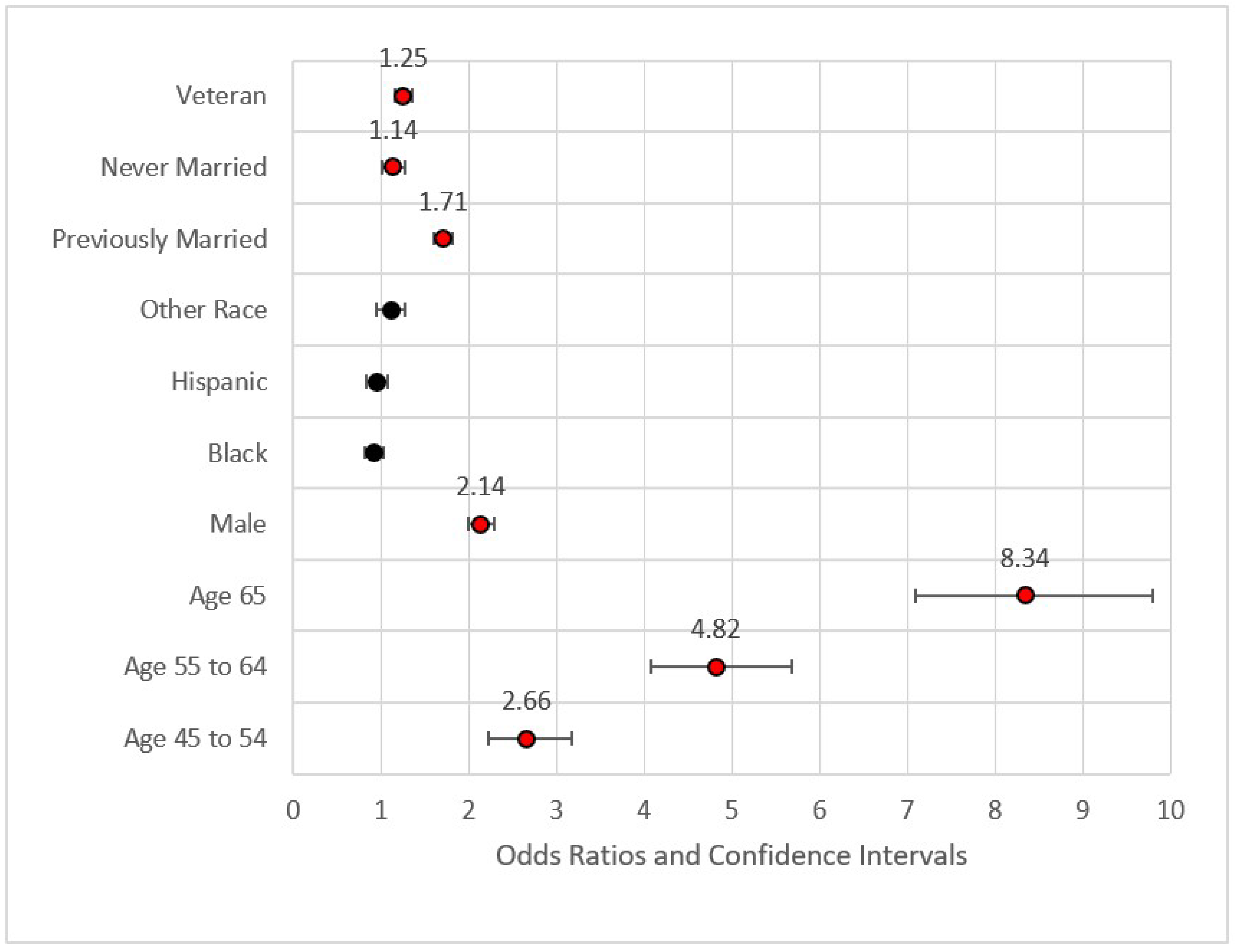
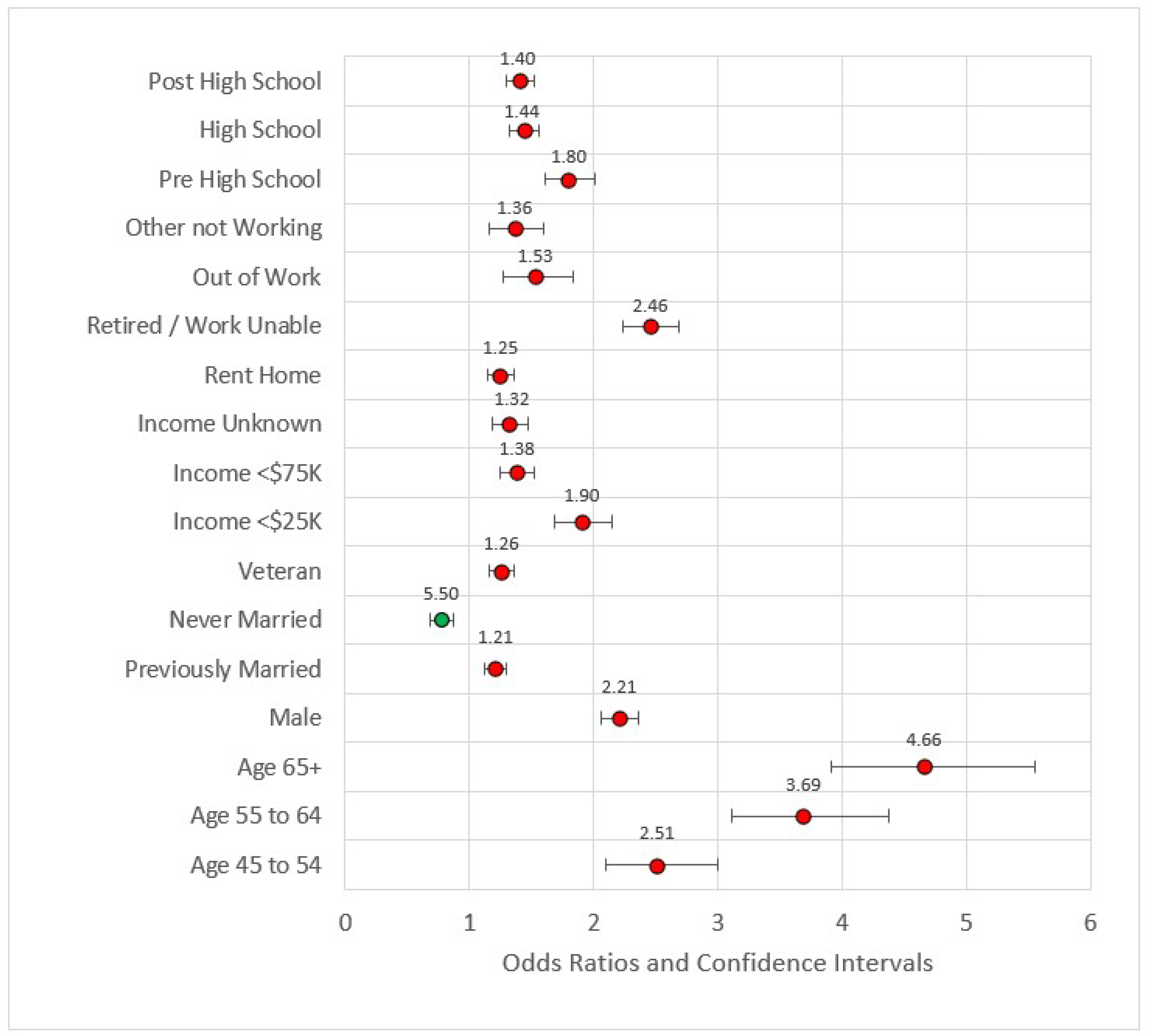
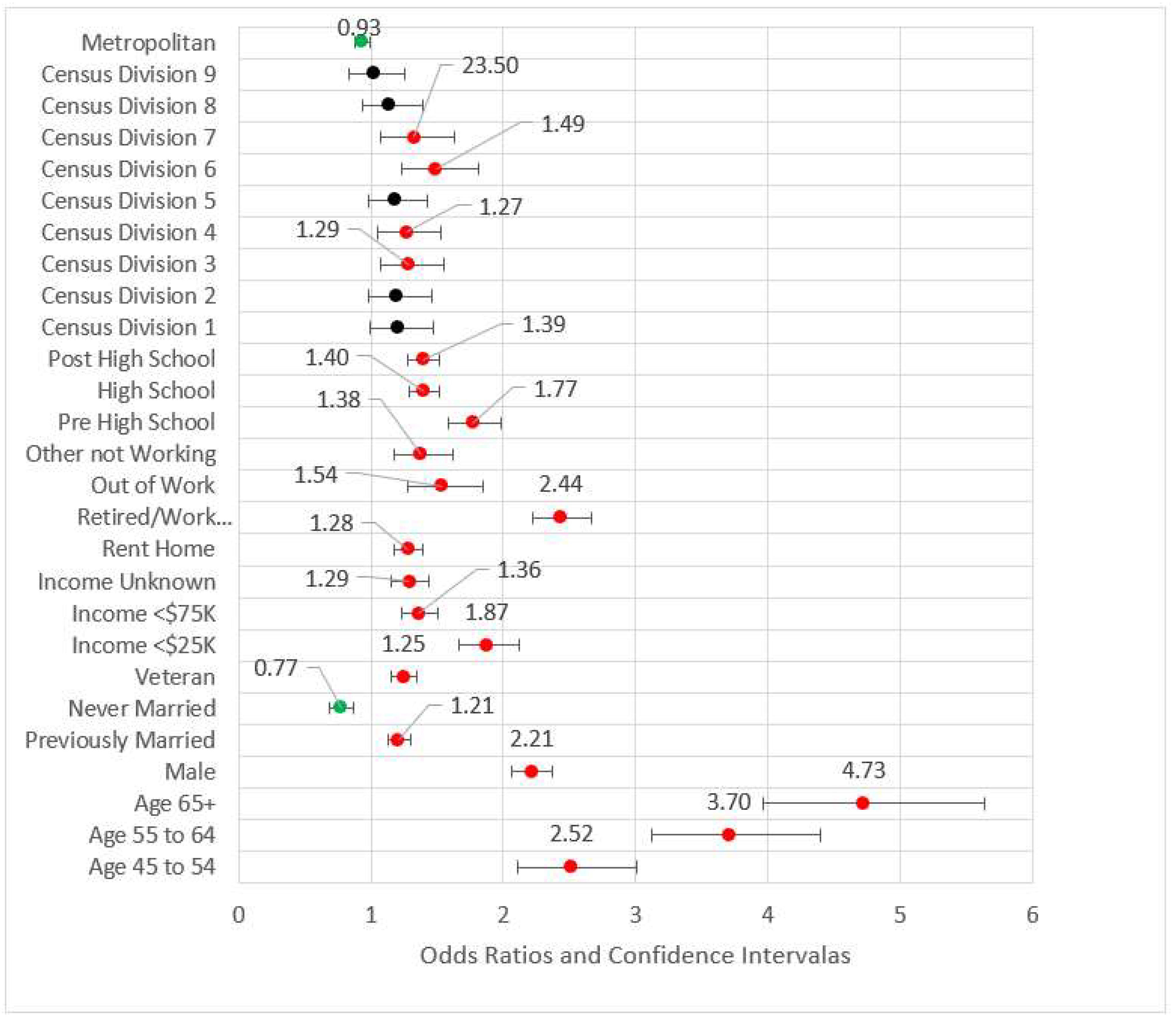
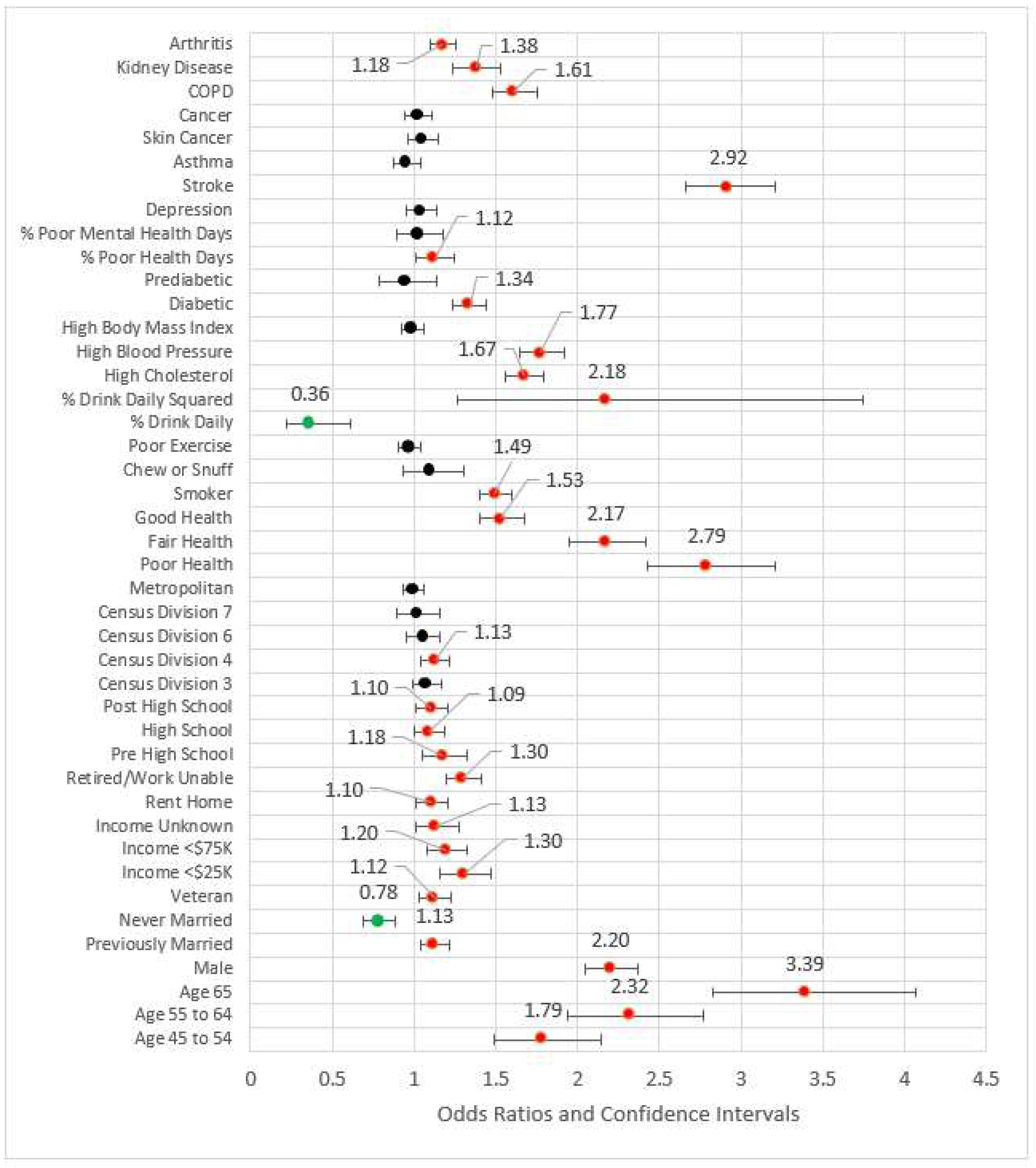
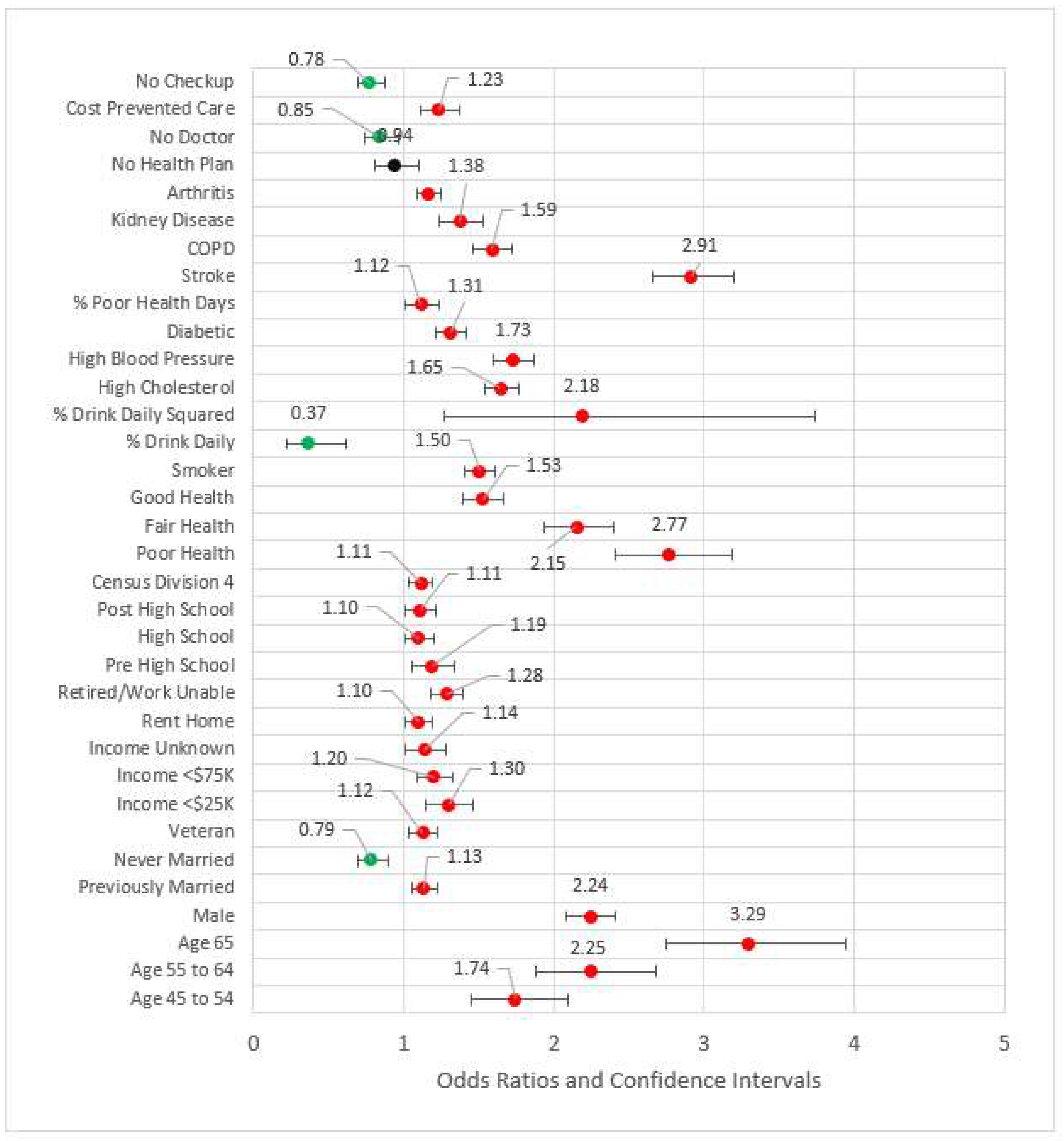
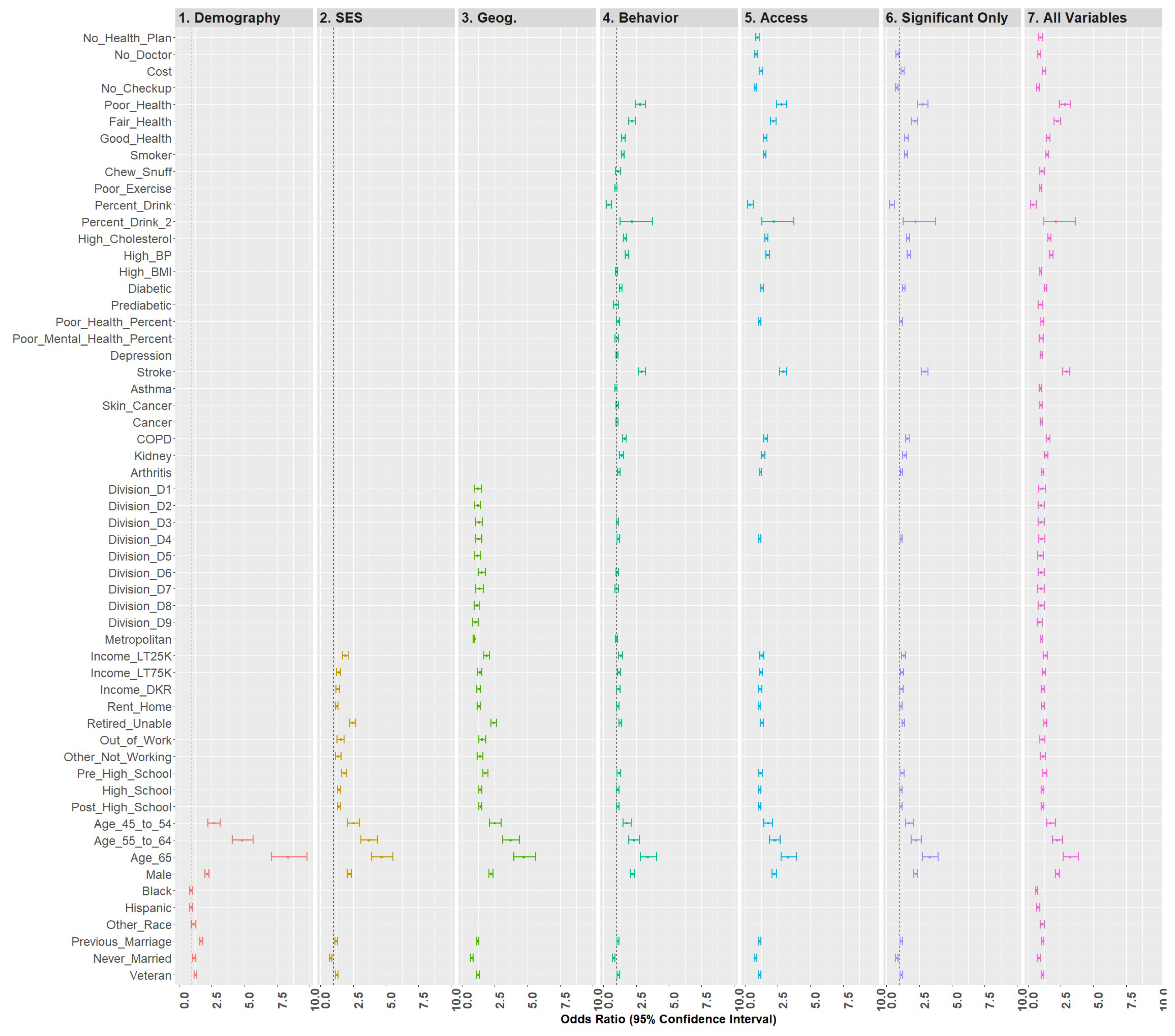

| 1 = New England | 2 = Middle Atlantic | 3 = East North Central | 4 = West North Central | 5 = South Atlantic |
|---|---|---|---|---|
| Connecticut | New Jersey | Indiana | Iowa | Delaware |
| Maine | New York | Illinois | Kansas | District of Columbia |
| Massachusetts | Pennsylvania | Michigan | Minnesota | Florida |
| New Hampshire | Ohio | Missouri | Georgia | |
| Rhode Island | Wisconsin | Nebraska | Maryland | |
| Vermont | North Dakota | North Carolina | ||
| South Dakota | South Carolina | |||
| Virginia | ||||
| West Virginia | ||||
| 6 = East South Central | 7 = West South Central | 8 = Mountain | 10 = Territories | |
| Alabama | Arkansas | Arizona | Guam | |
| Kentucky | Louisiana | Colorado | Puerto Rico | |
| Mississippi | Oklahoma | Idaho | ||
| Tennessee | Texas | New Mexico | ||
| Montana | ||||
| Utah | ||||
| Nevada | ||||
| Wyoming |
| Dependent Variable | Behaviors/Risks | ||
|---|---|---|---|
| Myocardial Infarction | 0.069 (0.057) | Asthma | 0.134 (0.133) |
| Demographics | Stroke | 0.053 (0.046) | |
| Age 35–44 (Referent) | 0.142 (0.231) | Depression | 0.183 (0.177) |
| Age 45–54 | 0.175 (0.229) | Prediabetic | 0.025 (0.026) |
| Age 55–64 | 0.241 (0.235) | Diabetic | 0.161 (0.150) |
| Age 65 | 0.443 (0.305) | High BMI | 0.643 (0.646) |
| Caucasian (Referent) | 0.789 (0.662) | High BP | 0.463 (0.418) |
| Black | 0.074 (0.114) | High Cholesterol | 0.398 (0.370) |
| Hispanic | 0.073 (0.149) | Skin Cancer | 0.118 (0.089) |
| Other Race | 0.064 (0.075) | Cancer | 0.120 (0.095) |
| Female (Referent) | 0.559 (0.523) | COPD | 0.097 (0.084) |
| Male | 0.441 (0.477) | Kidney | 0.045 (0.040) |
| Married (Referent) | 0.585 (0.633) | Arthritis | 0.388 (0.329) |
| Previously Married | 0.320 (0.260) | Limited Exercise | 0.279 (0.274) |
| Never Married | 0.095 (0.107) | Smoker | 0.428 (0.420) |
| Veteran | 0.141 (0.120) | Chew or Snuff | 0.029 (0.030) |
| Socioeconomics | % Mental Health Days | 0.114 (0.121) | |
| <$25 K Income | 0.201 (0.203) | % Physical Health Days | 0.159 (0.152) |
| <$75 K Income | 0.335 (0.340) | % Days Drinking | 0.154 (0.147) |
| Income-Refused | 0.175 (0.165) | % Days Drinking 2 | 0.101 (0.093) |
| ≥$75 K Income-(Referent) | 0.290 (0.292) | Poor Health | 0.060 (0.060) |
| Pre-High School | 0.073 (0.136) | Fair Health | 0.153 (0.159) |
| High School | 0.261 (0.260) | Good Health | 0.324 (0.327) |
| Post High School | 0.273 (0.295) | Very Good/Excellent | 0.463 (0.454) |
| College 4+ Years (Referent) | 0.394 (0.309) | Access | |
| Working | 0.460 (0.537) | No Primary Doctor | 0.130 (0.165) |
| Retired/Unable to Work | 0.449 (0.350) | Cost Prevented Care | 0.093 (0.116) |
| Out of Work | 0.032 (0.042) | No Annual Checkup | 0.169 (0.195) |
| Other Not Working | 0.058 (0.071) | No Health Plan | 0.068 (0.102) |
| Rent Home | 0.184 (0.189) | ||
| Geography | |||
| Metropolitan | 0.683 (0.840) | D6. East South Central | 0.063 (0.060) |
| D1. New England | 0.117 (0.049) | D7. West South Central | 0.069 (0.118) |
| D2. Middle Atlantic | 0.049 (0.102) | D8. Mountain | 0.131 (0.075) |
| D3. East North Central | 0.105 (0.146) | D9. Pacific | 0.095 (0.163) |
| D4. West North Central | 0.171 (0.065) | D10. Territories | 0.019 (0.011) |
| D5. South Atlantic | 0.182 (0.211) | (‘D#’ = division number) | |
| Metric | No MI | MI | Weighted Average |
|---|---|---|---|
| F1 Score | 0.940 | 0.339 | 0.898 |
| Precision | 0.926 | 0.406 | 0.890 |
| Recall | 0.954 | 0.291 | 0.908 |
| Accuracy | 0.926 | 0.406 | 0.890 |
| Support | 64,976 | 4860 | 69,836 |
Publisher’s Note: MDPI stays neutral with regard to jurisdictional claims in published maps and institutional affiliations. |
© 2021 by the authors. Licensee MDPI, Basel, Switzerland. This article is an open access article distributed under the terms and conditions of the Creative Commons Attribution (CC BY) license (https://creativecommons.org/licenses/by/4.0/).
Share and Cite
Dolezel, D.; McLeod, A.; Fulton, L. Examining Predictors of Myocardial Infarction. Int. J. Environ. Res. Public Health 2021, 18, 11284. https://doi.org/10.3390/ijerph182111284
Dolezel D, McLeod A, Fulton L. Examining Predictors of Myocardial Infarction. International Journal of Environmental Research and Public Health. 2021; 18(21):11284. https://doi.org/10.3390/ijerph182111284
Chicago/Turabian StyleDolezel, Diane, Alexander McLeod, and Larry Fulton. 2021. "Examining Predictors of Myocardial Infarction" International Journal of Environmental Research and Public Health 18, no. 21: 11284. https://doi.org/10.3390/ijerph182111284
APA StyleDolezel, D., McLeod, A., & Fulton, L. (2021). Examining Predictors of Myocardial Infarction. International Journal of Environmental Research and Public Health, 18(21), 11284. https://doi.org/10.3390/ijerph182111284







